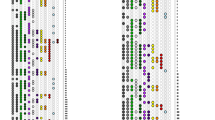Summary
Antibacterial substances are used in considerable amounts as growth promoters in animal husbandry. There are, however, incalculable risks for human health resulting from the use of particular feed additives. Even 30 years ago the detection of transferable antibiotic resistance inEnterobacteriaceae led to the demand that antibiotics used in human chemotherapy, or for which cross-resistance against human therapeutics has been demonstrated, should be prohibited as growth promoters. The application of molecular methods to typing and characterization of bacteria and their resistance genes has provided more concise evidence for the transfer of antibiotic resistance among animal husbandry and humans as to resistance to glycopeptides (vanA gene cluster) and to streptogramins (satA).
Similar content being viewed by others
References
Davies, J.: Inactivation of antibiotics and dissemination of resistance genes. Science 341 (1994a) 375.
Levy, S. B.: Balancing the drug resistance equation. Trends Microbiol. 2 (1994) 341.
Levy, S. B., Fitzgerald, G. B., Macone, A. B.: Spread to antibiotic resistance plasmids from chicken to chicken and from chicken to man. Nature 260 (1976) 40–42.
Linton, A. H., Howe, K., Bennet, P. M., Richmond, M. H.: The colonization of the human gut by antibiotic-resistantEscherichia coli from chickens. J. Appl. Bacteriol. 43 (1977) 465–469.
Smith, H. W.: The transfer of antibiotic resistance between strains of enterobacteria in chicken, calves and pigs. J. Med. Microbiol. 3 (1970) 165–180.
Tschäpe, H., Rische, H.: Ökologie und epidemiologische Bedeutung der infektiösen Chemotherapeutikaresistenz. J. A. Barth, Leipzig 1974.
N. N.: Report of joint committee on the use of antibiotics in animal husbandry and veterinary medicine. Swann Committee, Her Majesty's Stationery Office, London, September 1969.
Helmuth, R., Bulling, E. (eds.): Criteria and methods for the microbiological evaluation of growth promoters in animal feeds. Bundesgesundheitsamt Berlin 1985.
Arthur, M., Courvalin, P.: Genetics and mechanisms of glycopeptide resistance in enterococci. Antimicrob. Agents Chemother. 37 (1993) 1563–1571.
Arthur, M., Reynolds, P., Courvalin, P.: Glycopeptide resistance in enterococci. Trends Microbiol. 4 (1996) 401–407.
Klare, I., Witte, W.: Glykopeptidresistente Enterokokken: Auftreten, Verbreitung, Resistenzübertragung, Bedeutung. Wien Klin. Wochenschr. 109 (1997) 293–300.
Klare, I., Heier, H., Claus, H., Witte, W.: Environmental strains ofEnterococcus faecium with inducible high-level resistance to glycopeptides. FEMS Microbiol. Lett. 106 (1993) 23–90.
Klare, I., Heier, H., Claus, H., Reissbrodt, R., Witte, W.:vanA-mediated high-level glycopeptide resistance inEnterococcus faecium from animal husbandry. FEMS Microbiol. Lett. 125 (1995) 165–172.
Chadwick, P. R., Woodford, N., Banell, R. A., Oppenheim, B. A.: Glycopeptide-resistant enterococci isolated from uncooked meat. J. Antimicrob. Chemother. 38 (1996) 908–909.
Klare, I., Heier, H., Claus, H., Böhme, G., Marin, S., Seltmann, G., Hakenbeck, R., Atanassova, V., Witte, W.:Enterococcus faecium strains withvanA-mediated high-level glycopeptide resistance isolated from animal food-stuffs and fecal samples of humans in the community. Microb Drug Resist. 1 (1995) 265–272.
Schouten, M. A., Voss, A.: VRE and meat. Lancet 349 (1997) 1258.
Werner, G., Klare, I., Witte, W.: Arrangement of thevanA gene cluster in enterococci of different ecological origin. FEMS Microbiol. Lett. 155 (1997) 55–61.
Jensen, L. B., Ahrens, P., Dons, L., Jones, R., Hammerum, A. M., Aarestrup, F. M.: Molecular analysis of Tn1546 inEnterococcus faecium isolated from animals and humans. J. Clin. Microbiol. 36 (1998) 437–442.
Woodford, N., Adebiyi, A. M., Palepon, M. F., Cookson, B.: Diversity ofvanA glycopeptide resistance elements in enterococci from human and nonhuman sources. Antimicrob. Agents Chemother. 42 (1998) 502–508.
Simonsen, G., Haaheim, H., Dahl, K. H., Kruse, H., Loveseth, A., Olsvik, O., Sundsfjord, A.: Transmission ofvanA type vancomycin-resistant enterococci andvanA resistant elements between chicken and humans at avoparcin exposed farms. Microb Drug Res. 4 (1998) 313–318.
Van den Braak, N., Van Belkum, A., Keulen, J., Vliegenhart, J., Verbrugh, H. A., Endz, H. P.: Molecular characterization of vancomycin-resistant enterococci from hospitalized patients and poultry products in The Netherlands. J. Clin. Microbiol. 36 (1998) 1927–1932.
Werner, G., Klare, I., Witte, W.: Association between quinupristin/dalfopristin resistance in glycopeptide-resistantEnterococcus faecium and the use of additives in animal feed. Eur. J. Clin. Microbiol. Infect. Dis. 17 (1998) 401–402.
WHO: The medical impact of the use of antimicrobials in food animals. Report of a WHO meeting. WHO/EMC/ZOO/97.4 (1997).
Witte, W.: Impact of antibiotic use in animal feeding on resistance of bacterial pathogens in humans. In:Levy, S. B. (ed.): Antibiotic resistance: origins, evolution, selection, and spread. Wiley, Chichester 1997, pp. 71–85.
Witte, W.: Medical consequences of antibiotic use in agriculture. Science 279 (1998) 996–997.
Klare, I., Badstübner, D., Konstabel, C., Böhme, G., Claus, H., Witte, W.: Decreased incidence of VanA type vancomycin-resistant enterococci isolated from poultry meat and from faecal samples of humans in the community after discontinuation of avoparcin usage in animal husbandry. Microb. Drug Resist. 5 (1999) (in press).
Kirst, H. A., Thompson, D. C., Nicas, Th.: Historical yearly usage of vancomycin. Antimicrob. Agents Chemother. 42 (1998) 1303–1304.
Antimicrobial Feed Additives Commission: Antimicrobial feed additives. Governmental Official Reports 132, Stockholm 1997.
Author information
Authors and Affiliations
Rights and permissions
About this article
Cite this article
Witte, W., Klare, I. & Werner, G. Selective pressure by antibiotics as feed additives. Infection 27 (Suppl 2), S35–S38 (1999). https://doi.org/10.1007/BF02561669
Issue Date:
DOI: https://doi.org/10.1007/BF02561669




